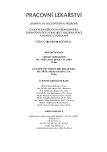Is it possible to increase the effectiveness of the treatment of professional disorders of the locomotor apparatus?
Authors:
A. Zlámal
Authors‘ workplace:
MEDIRECO, a. s., Brno-Židenice
Published in:
Pracov. Lék., 61, 2009, No. 3, s. 113-116.
Category:
Original Papers
Overview
Damage of musculoskeletal apparatus and lower extremity nerves related to longterm excessive overload is one of the most frequent problems in occupational medicine. The most frequent are diseases like isthmus syndromes, epicondylitis and tendovaginitis – especially of forearm flexors. The author recommends system enzymotherapy as a part of comprehensive conservative treatment for a couple of years. He presents retrospective evaluation and comparison of length of work inability in 72 patients (working in car industry), who were treated at the factory medical office by the practitioner for the period of nine months in 2008/2009. The half of patients (n = 36) was treated by obligatory prescribed medication, i. e. analgetics and locally applied nonsteroid antiphlogistic. The second half of patients (n = 36) decided to add Wobenzym to the obligatory medication upon the recommendation of the physician.
The average length of the treatment with obligatory medication was 143.8 ± 23.4 days; the combined treatment with Wobenzym shortened to 62.16 ± 9.4 days – i. e. it was 81.64 days shorter (by 56.73 %). Statistical analysis proved the highly significant difference.
Key words:
longterm excessive overload, system enzymotherapy, treatment length
Sources
1. Wobenzym – SPC přípravku:
http://www.sukl.cz/download/spc/SPC84472.doc.
2. Phlogenzym – SPC přípravku:
http://www.sukl.cz/download/spc/SPC9616.doc.
3. AKHTAR, N. M., NASEER, R., FAROOQI, A. Z., AZIZ, W., NAZIR, M. Oral enzyme combination versus diclofenac in the treatment of osteoarthritis of the knee – a double blind prospective randomized study. Clin. Rheumatol., 2004, 23, č. 5, s. 410–415.
4. BRHEL, P. Problematika nemocí z povolání v praxi praktického lékaře. Med. pro Praxi, 2006, č. 6, s. 264–267. Dostupnéna:
5. ERNST, E. Oral therapy with proteolytic enzymes: Effects on hemorheological parameters. Perfusion, 1994, č. 12, s. 440–441.
6. FIALOVÁ, J., BARTOUSEK, J., NAKLÁDALOVÁ, M. Alternative treatment of the capal tunnel syndrome. Cent. Eur. J. Public. Health, 1999, 7, č. 4, s.168–171.
7. KAMENÍČEK, V., HOLAŇ, P., FRANĚK, P. Systémová enzymoterapie v léčbě a profylaxi potraumatických a pooperačních otoků. Acta Chir. Ortoped. et Trauý. m. Čech., 2001, č. 1, s. 45–49.
8. KLEIN, G., KULLICH, W., SCHNITKER, J., SCHWANN, H. Efficacy and tolerance of an oral enzyme combination in painful osteoarthritis of the hip. A double-blind, randomised study comparing oral enzymes with non-steroidal anti-inflammatory drugs. Clin. Exp. Rheumatol., 2006, 24, č. 1, s. 25–30.
9. OLEJÁR, T., POUČKOVÁ, P., ZADINOVÁ, M. Systémová enzymoterapie ve sportovním lékařství – Obecné principy, indikace a klinické zkušenosti. Med. Sport Bohem. Slov., 1998, 7, č. 4, s. 113–115.
10. RAHN, H. D. Begleitende Therapie durch hydrolytische Enzyme bei arthroskopischer Meniskuresektion. Prakt. Sport-Traumatologie und Sportmedizin, 1994, 10, č. 3, s. 123–127.
11. SMRČKA, M., VYBÍHAL, V., NĚMEC, M. Syndrom karpálního tunelu. Neurol. pro praxi, 2007, 8, č. 4, s. 243–246. Dostupné na:
http://solen.cz/pdfs/neu/2007/04/14.pdf
12. WITTENBORG, A., BOCK, P. R., HANISCH, J., SALLER, R., SCHNEIDER, B. Comparative epidemiological study in patients with rheumatic diseases illustrated in an example of a treatment with non-steroidal anti-inflammatory drugs versus an oral enzyme combination. Arzneim.-Forsch/Drug Res., 2000, 50 (II), č. 8, s. 728–738.
Labels
Hygiene and epidemiology Hyperbaric medicine Occupational medicineArticle was published in
Occupational Medicine

2009 Issue 3
Most read in this issue
- The way we acknowledge occupational diseases of respiratory pathways, lungs and pleura
- Painful impairment of the locomotor apparatus at work in the office
- Professional pneumopathies and current options of rehabilitation treatment
- Analysis of incidence of tick encephalitis as an occupational disease in the Slovak Republic and the Czech Republic in 1989–2008
